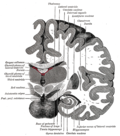Somatosensory system
Somatosensory System
The Somatosensory system is a complex system of sensory neurons and pathways that responds to changes at the surface or inside the body. The axons (as afferent nerve fibers) of sensory neurons connect with, or respond to, various receptor cells. These sensory receptor cells are activated by different stimuli such as heat and nociception, giving a functional name to the responding sensory neuron, such as a thermoreceptor which carries information about temperature changes.
Structure[edit]
The somatosensory system is spread throughout all major parts of our body. At its simplest, the system works when neurons in the body sense changes in the environment, such as heat or light, and send these signals to the brain. This process occurs in two stages: transduction and transmission.
Transduction[edit]
Transduction occurs when a sensory neuron converts a specific type of physical energy into electrical signals. This process is achieved through the activation of transduction channels within the sensory neuron that convert the energy into electrical signals.
Transmission[edit]
Transmission is the process by which the electrical signals are sent from the sensory neuron to the brain. This is achieved through the activation of voltage-gated ion channels that propagate the electrical signal along the axon of the neuron.
Function[edit]
The somatosensory system is responsible for processing sensory information from the body. This includes touch, temperature, body position, and pain signals. The system is critical for our ability to interact with the environment and react to potential threats.
Clinical significance[edit]
Damage to the somatosensory system can result in a variety of neurological conditions, such as somatosensory disorders, which can affect a person's ability to perceive touch, temperature, body position, and pain.
See also[edit]
References[edit]
<references />
|
|
|
-
Tactile markings on stairs for visually impaired
-
Comprehensive list of relevant pathways for the somatosensory system
-
Diagram of the somatosensory pathways
-
Cross-section of the spinal cord showing somatosensory tracts
-
Illustration of tickle sensation
-
Sensory homunculus representation
Ad. Transform your life with W8MD's Budget GLP-1 injections from $75


W8MD offers a medical weight loss program to lose weight in Philadelphia. Our physician-supervised medical weight loss provides:
- Weight loss injections in NYC (generic and brand names):
- Zepbound / Mounjaro, Wegovy / Ozempic, Saxenda
- Most insurances accepted or discounted self-pay rates. We will obtain insurance prior authorizations if needed.
- Generic GLP1 weight loss injections from $75 for the starting dose.
- Also offer prescription weight loss medications including Phentermine, Qsymia, Diethylpropion, Contrave etc.
NYC weight loss doctor appointmentsNYC weight loss doctor appointments
Start your NYC weight loss journey today at our NYC medical weight loss and Philadelphia medical weight loss clinics.
- Call 718-946-5500 to lose weight in NYC or for medical weight loss in Philadelphia 215-676-2334.
- Tags:NYC medical weight loss, Philadelphia lose weight Zepbound NYC, Budget GLP1 weight loss injections, Wegovy Philadelphia, Wegovy NYC, Philadelphia medical weight loss, Brookly weight loss and Wegovy NYC
|
WikiMD's Wellness Encyclopedia |
| Let Food Be Thy Medicine Medicine Thy Food - Hippocrates |
Medical Disclaimer: WikiMD is not a substitute for professional medical advice. The information on WikiMD is provided as an information resource only, may be incorrect, outdated or misleading, and is not to be used or relied on for any diagnostic or treatment purposes. Please consult your health care provider before making any healthcare decisions or for guidance about a specific medical condition. WikiMD expressly disclaims responsibility, and shall have no liability, for any damages, loss, injury, or liability whatsoever suffered as a result of your reliance on the information contained in this site. By visiting this site you agree to the foregoing terms and conditions, which may from time to time be changed or supplemented by WikiMD. If you do not agree to the foregoing terms and conditions, you should not enter or use this site. See full disclaimer.
Credits:Most images are courtesy of Wikimedia commons, and templates, categories Wikipedia, licensed under CC BY SA or similar.
Translate this page: - East Asian
中文,
日本,
한국어,
South Asian
हिन्दी,
தமிழ்,
తెలుగు,
Urdu,
ಕನ್ನಡ,
Southeast Asian
Indonesian,
Vietnamese,
Thai,
မြန်မာဘာသာ,
বাংলা
European
español,
Deutsch,
français,
Greek,
português do Brasil,
polski,
română,
русский,
Nederlands,
norsk,
svenska,
suomi,
Italian
Middle Eastern & African
عربى,
Turkish,
Persian,
Hebrew,
Afrikaans,
isiZulu,
Kiswahili,
Other
Bulgarian,
Hungarian,
Czech,
Swedish,
മലയാളം,
मराठी,
ਪੰਜਾਬੀ,
ગુજરાતી,
Portuguese,
Ukrainian







